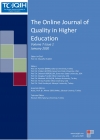TOJQIH - Volume 3 - Issue 4 - October 2016
 DISCUSSION METHOD AND ITS EFFECT ON THE PERFORMANCE OF STUDENTS IN READING COMPREHENSION IN SECONDARY SCHOOLS IN PLATEAU STATE
DISCUSSION METHOD AND ITS EFFECT ON THE PERFORMANCE OF STUDENTS IN READING COMPREHENSION IN SECONDARY SCHOOLS IN PLATEAU STATE Hanna Onyi Yusuf, Ayuba Guga, Adamu Ibrahim
Abstract:
The study investigated the effect of Discussion method on the performance of
students in reading comprehension in secondary schools in Plateau state. The study
adopted a quasi-experimental pre-test and post-test control group design. Two randomly
selected Government Secondary Schools from Jos North and Jos South Local
Government Areas were used for the study. One hundred (100) senior secondary class II
students from two intact classes were used for the study (i.e. 50 students per class, per
school). Government Secondary School, Jos, was used as the experimental group while
Government Secondary School, Bukuru, was used as the control group. Students from
both groups were pre-tested to establish the homogeneity of the two groups before the
commencement of the treatment to the experimental group. Both groups were taught for
eight weeks. Students were tested using an instrument called a cloze reading
comprehension test. The hypothesis postulated for the research was tested using T-test
as a statistical tool at 0.05 level of significance. The findings indicated that there was a
significant difference in the pre-test and post-test mean scores of students in the
experimental and control groups. The result further revealed a higher mean score of
students taught reading comprehension using the discussion method as compared with
those taught using the conventional method. Based on this finding, the study
recommended that teachers should be encouraged to use discussion method alongside
the conventional method to enrich their reading comprehension lessons. Curriculum
planners and textbook writers should equally provide topical issues/discussion topics
before, during and after every reading task to make reading comprehension lessons
more participatory, meaningful, purposeful, exciting, enjoyable and pleasurable.
 IMPLEMENTATION OF SIX SIGMA METHODOLOGY (DMAIC) FOR THE ENHANCEMENT OF LEARNING & MOTIVATION LEVELS OF STUDENTS
IMPLEMENTATION OF SIX SIGMA METHODOLOGY (DMAIC) FOR THE ENHANCEMENT OF LEARNING & MOTIVATION LEVELS OF STUDENTS Muhammad Yousaf Jamil
Abstract:
Our aim of this study is to evaluate the relationships of dependant variables
i.e. learning levels (based upon Bloom’s taxonomy), motivation & results of students
against the factors of Batch #, Semester #, time for study at home, program, subjects,
topics, age, gender, graduation background, selection of topic for research from this
course, application of this course in job and relevance of topic to career in general.
Learning levels include Knowledge, Comprehension, Application, Analysis and
Synthesis. The marking to these levels signify 1,2,3,4 & 5 respectively. The motivation,
learning and result levels were measured through Likert scale of 1 – 5 (1 being the least
and 5 the highest). The result levels were also converted to a scale of 1 – 5 (by dividing
the marks obtained in a subject by total marks and then multiplying by 5).The process
included obtaining feedback from the students of relevant programs on prescribed
formats.
Abbreviations used: Motivation (M), Result (R) & Learning (L).
Six Sigma methodology (DMAIC) was utilized, in order to define and measure the
existing sigma level and the steps which should be taken in order to enhance learning
and motivation level of students which in turn will enhance Sigma level as well. This
study embeds the concept of Bloom’s taxonomy with Six Sigma methodology which
was applied to the M.Sc & M.S programs of Quality and Human Resource
Management.
After implementation of the proposed solutions, it is anticipated that the sigma level
will be improved from 3.45 to 3.85 approx, the defect rate would be reduced from
13.36 % to 4.39 %. After implementation of the proposed solutions, in the next
academic session 9.0 % enhancement in the present revenue (in the form of fees) is
expected because of the increased number of intakes (students) due to enhanced level
of learning and motivation levels of students.
 INFLUENCE OF STUDENTS' SATISFACTION WITH STUDENT LIFE QUALITY ON THEIR PERFORMANCE: THE CASE OF HIGHER EDUCATION INSTITUTIONS IN PORTUGAL
INFLUENCE OF STUDENTS' SATISFACTION WITH STUDENT LIFE QUALITY ON THEIR PERFORMANCE: THE CASE OF HIGHER EDUCATION INSTITUTIONS IN PORTUGAL Zoran Mihanović, Kristina Zekić
Abstract:
This paper discusses the student satisfaction, student’s life quality and their
performance. The main goal of this paper is to further elaborate which factor influences
the overall student life satisfaction to the greatest extent. Furthermore, the aim of this
paper is to establish if there is a direct link between student life satisfaction and life in
general and the link between student life satisfaction and students’ performance. The
verification of research goals is based on the review of literature. On the basis of
previous research, a valid research instrument was created. The verification of research
goals are empirically analysed among the students of the University ofAveiro,
Portugal.It is believed that research results can assist managers of educational
institutions in creating a strategy, leading to the better students satisfaction with student
life quality and there performances.
 REFLECTIONS ON READINESS OF FRESHMAN STUDENTS IN UNDERGRADUATE MATHEMATICS
REFLECTIONS ON READINESS OF FRESHMAN STUDENTS IN UNDERGRADUATE MATHEMATICS Yusuf AYDIN
Abstract:
In this study , we attempted to understand the problems associated with
learning processes of function concept within freshman mathematics classroom.
Before starting to teach Function Concept to the General Mathematics class of freshman
students , we applied a diagnostic test with a single question.“Define the Function
Concept and decide which of the following relations can be a function?”
Then we delivered the Function Concept to the class in a lecture mode of teaching and
give various counter examples of relations which are a function or not a function. Then
as a post -test we asked the same question to the same class to measure any gain of
the function concept. Unfortunately, we did not get any satisfactory improvement in
the formation of the Function Concept.The results are given in the paper.
 THE HIGHER EDUCATION SYSTEM: A COMPARISON OF STUDENTS AND UNIVERSITIES OF HIGHER EDUCATION OF BRAZIL AND TURKEY
THE HIGHER EDUCATION SYSTEM: A COMPARISON OF STUDENTS AND UNIVERSITIES OF HIGHER EDUCATION OF BRAZIL AND TURKEY Mustafa Kemal Ă–KTEM, Erica MACEDO DE SOUZA
Abstract:
The higher education has been directly associated with human, economic and
social development, for this reason the access and permanence in the university are
envisioned goals by developing countries such as Brazil and Turkey. Both countries are
classified by the World Bank as developing countries and are in the same index rating
range of human development (HDI) by the United Nations Development Programme.
This documental review study aims to present the analysis of a comparative mapping
between students aspects of Higher Education of Brazil and Turkey. To this end, it was
used the data published in 2013 by the National Institute of Studies and Educational
Research Anísio Teixeira (INEP), a federal public entity under the Ministry of
Education of Brazil and The Council of Higher Education (YükseköÄźretim Kurulu,
YÖK) of Turkey, with 2012 as the base year. In addition to the general data of the two
countries has been presented and analyzed information on the particularities of higher
education institutions regarding their classification as public and private. It was
observed that the Brazilian and Turkish reality differs in both quantitative and
qualitative aspects, such as the number and types of educational institutions, the forms
of student enrollment at the university and enrollment in public and private institutions.
On the other hand, there are similarities that point to universal trends such as the current
increase of female presence and democratization efforts of higher education. Although
the forms of access to higher education differ substantially between these countries,
there are common challenges involving the inequalities in higher education, following
the population growth and the demand that meets aspects that shape the standard in
quality education.
 THE INTERACTIONAL FEATURES OF ENGLISH CLASSROOM DISCOURSE IN THE MUÄžLA CONTEXT
THE INTERACTIONAL FEATURES OF ENGLISH CLASSROOM DISCOURSE IN THE MUÄžLA CONTEXT Perihan KORKUT, Abdullah ERTAĹž
Abstract:
In the literature, there is a call for research with accounts for research for
localization of teaching practices (ÇakıroÄźlu & ÇakıroÄźlu, 2003; Walsh, 2006; Sert,
2010). As a response to that call, this study sets out to explore possible areas of
improvement in the language teacher training program based on real classroom data in
the context of MuÄźla. Lessons from 10 state school English teachers of varying
experience and 7 teacher trainees from MuÄźla Sıtkı Koçman University were recorded,
transcribed and analyzed according to Walsh’s (2006) “Self Evaluation Teacher Talk
(SETT)” framework. A qualitative, ethnographic research perspective is adopted. The
trustworthiness of the research is ensured by various strategic undertakings. The
findings confirmed the same pedagogic goals and interactional features pertaining to
each mode described in the SETT framework. There have been observed, however,
additional pedagogic goals in managerial, materials and classroom context modes along
with some context specific interactional features.


